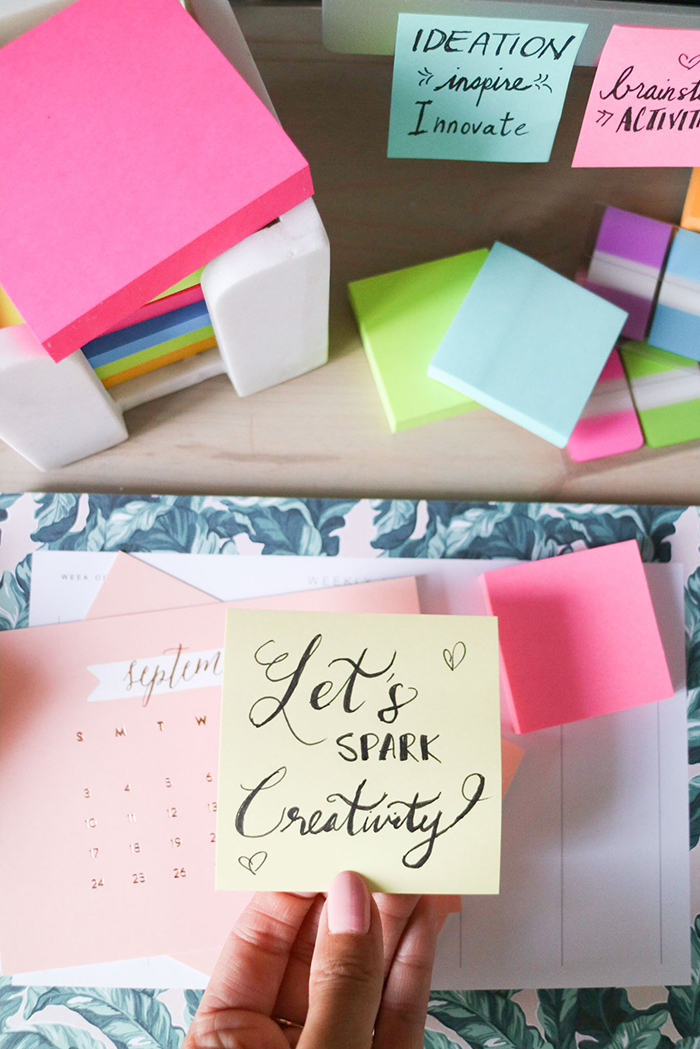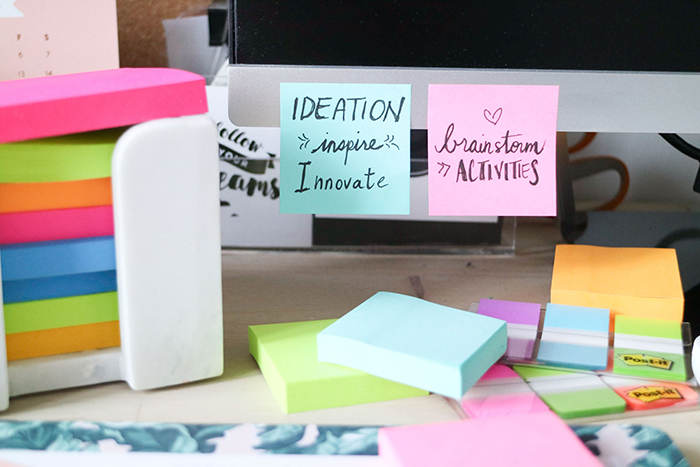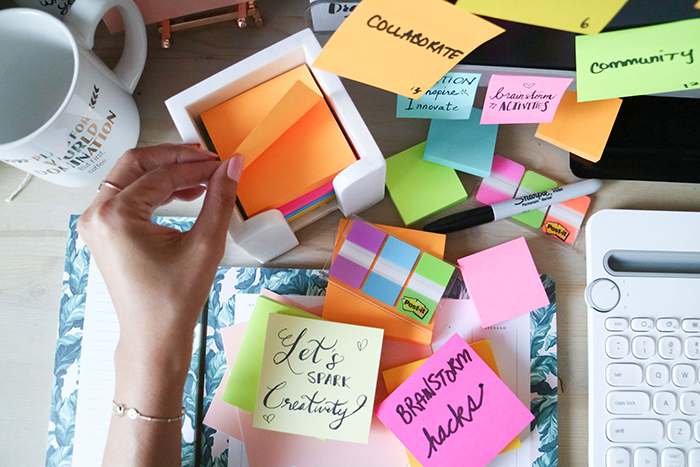Truth, we are all creative people.
The dictionary definition of ‘creative’ is someone who has the power or desire to create. And to create, is simply bringing something into existence. If that’s the case, don’t you agree that both you and I are creative human beings? Too often, the term ‘creative’ is misinterpreted as being ‘artistic’ and unfortunately, this has hindered so many of us (and businesses) from designing and establishing new ideas and initiatives.
In both my full-time marketing career and life as a blogger/influencer, I am required to be creative. That means, people (and organizations) depend on me to originate, ideate, and make. And though I do believe that I’ve got a few more creative bones than the average person, I too, often get stuck in a creative rut.
So, what’s a girl to do to get the creative juices flowing again?

After months of practice, and the completion of a two-day Harvard University Design Thinking workshop (ahem!), I’ve discovered my personal formula that begins with finding the right environment, coupled with a few individual brainstorming exercises and well loads of Post-It® Notes and a giant cup of coffee!

In the past year, I’ve had the opportunity to work with many innovation experts. They are stellar at solving problems, and sometimes, even problems that haven’t been realized! I was intrigued by their ‘innovation’ spirit, and through this exploration, I learned that there are consistent approaches and methods (i.e. Design Thinking) you can apply to problem solving and being creative is also an iterative journey rather than a destination.
If you find yourself running out of creative juice, I encourage you to try some of these brainstorming exercises I’ve found most useful.
Materials You Need for ‘Effective Brainstorming’:
- Few pads of Post-It® Notes (I recommend the Post-it® Super Sticky Notes Rio de Janeiro Collection)
- Pens/Markers
- A large working surface
- Don’t forget your brain!
Three Effective Brainstorming Exercises to Spark Creative Thinking
1. Customer/Stakeholder Needs
When you’re stuck, the most important task on hand is to figure out the problem you’re trying to solve. Whatever it is that you’re trying to create, whether that is writing a blog post, coming up with a new business model, or have been tasked to come up with a new product – always start with defining the problem. To do so, you’ll need to understand who is benefitting from your creation, that person can be you, a client, a colleague, or your readers – and what their needs and desired outcomes are.
Follow these Steps to Begin:
- Who You Are Trying to Solve For: Identify the key stakeholders (beneficiaries). For example, if you are a writer and someone has asked you to write an article the stakeholders that will benefit from this piece are you, the readers, the outlet that had requested this article and the subject you are writing about.
- Arranging Stakeholders: Once you’ve determined who the key parties are, ensure each party is written on one Post-It® Note (preferably using all the different bright colours!) and lay each out on a working surface, either arranged in rows or columns.
- Identifying Needs: At this point, using your pad of Post-It® Notes, for each stakeholder identified, write down as many needs as possible for each grouping and place the Post-It® Notes under that specific stakeholder (either in rows or columns depending on your original set up). For example for a reader, the need of reading the article perhaps is to gain knowledge.
- Prioritizing Needs: If your creative juices have started to flow, chances are, you’ve written down many needs. Now, you want to prioritize the needs by selecting a maximum of two per stakeholder.
At the end of this exercise, you’ve come away with understanding who you are creating for and what their needs and desires are.
2. Journey Mapping (Pain Points and Opportunities)
The objective of this brainstorming activity is the empathize with the stakeholders you’ve identified in the previous exercise and to really understand what the pain points and opportunities are. This will help you come up with your future solution!

Follow these steps to begin:
- Setting Up: Place the stakeholders in one column vertically on a large working surface.
- Identifying the Entire Journey: Start to think about the entire journey of the problem on hand. Using the previous example, what is the entire journey (phases) of writing the article. This may start with research, gathering information, writing the draft article, publishing the article, reading the article, etc.
- Arranging the Journey: Write down each step of the journey on one Post-It® Note and place it horizontally across at the top on the working surface.
- Identifying Pain Points: Now, its time to brainstorm. For each stakeholder at each step of the journey, identify all the potential pain points that they may be experienced. Write down each pain point (one per Post-it® Note) and place it under the column of the journey phase and which stakeholder it impacts.
- Identifying Opportunities: Once you’ve mapped out all the pain points, step back and look at any potential opportunities. For example, if gathering research materials for the article is a pain point for the writer, perhaps there is a potential opportunity to reduce this challenge – i.e. this is what may be causing the creative rut in the first place!
- Prioritize: Always take a step back and prioritize which pain points are the most important and what opportunities have the biggest impact (keep it slim, maximum two per).
3. Rapid Brainstorming – 50 Ideas in 12 Minutes
Now that you understand who you’re trying to solve for and what the pain points and opportunities are, it’s time to find a solution to the problem! I love this rapid brainstorming exercise, this exercise as a standalone can also be very powerful!

Once again using my original example, we’ve identified that for the writer, a pain point is gathering research, and the opportunity is perhaps finding additional sources of information.
The objective of this exercise is to keep your brain going and to rapid fire 50 ideas (or more) within 12 minutes that can potentially be a solution to the problem (in this case, the research gathering phase).
Follow these steps to begin:
- Label the corners of a pad of Post-it® Notes, from 1 to 50.
- Start a timer, counting down from 12 minutes.
- Jot down as many ideas as possible, one idea per Post-it® Note, up to 50 (or even more)
- Rule of thumb is NEVER stop writing, so even if you’re stuck, just write down the first word that comes to mind!
- When time’s up, cluster the ideas into categories on a working surface, you’ll find that some may have repeated or are very similar
It will become very clear based on the similarities and repetition that some ideas are worth spending time on whereas others don’t have much of an impact.
Using our example again, perhaps social media or the library, or asking a friend were ideas that were written down for the research gathering phase.

The great thing about these brainstorming exercises is that they can be conducted individually or with a team. I’ve tried these activities both on my own when I’m stuck and with my team at work, and it is amazing how many great ideas can come about and how much more you will understand the people you are trying to solve for!
There are so many fabulous uses for Post-it® Notes, but brainstorming and ideation is definitely one of my musts. Whether you’re back to school or back to the office, Post-it® Notes is an essential tool for creative thinking and problem solving!
For more great ideas on how to use Post-it® Notes, visit the Inspiration That Sticks blog for plenty of Work Hacks and Life Hacks!
How do you get out of your creative rut?
Disclaimer: I am proud to be a 3M sponsored blogger, and as part of my responsibilities, I get the opportunity to evaluate 3M products.

